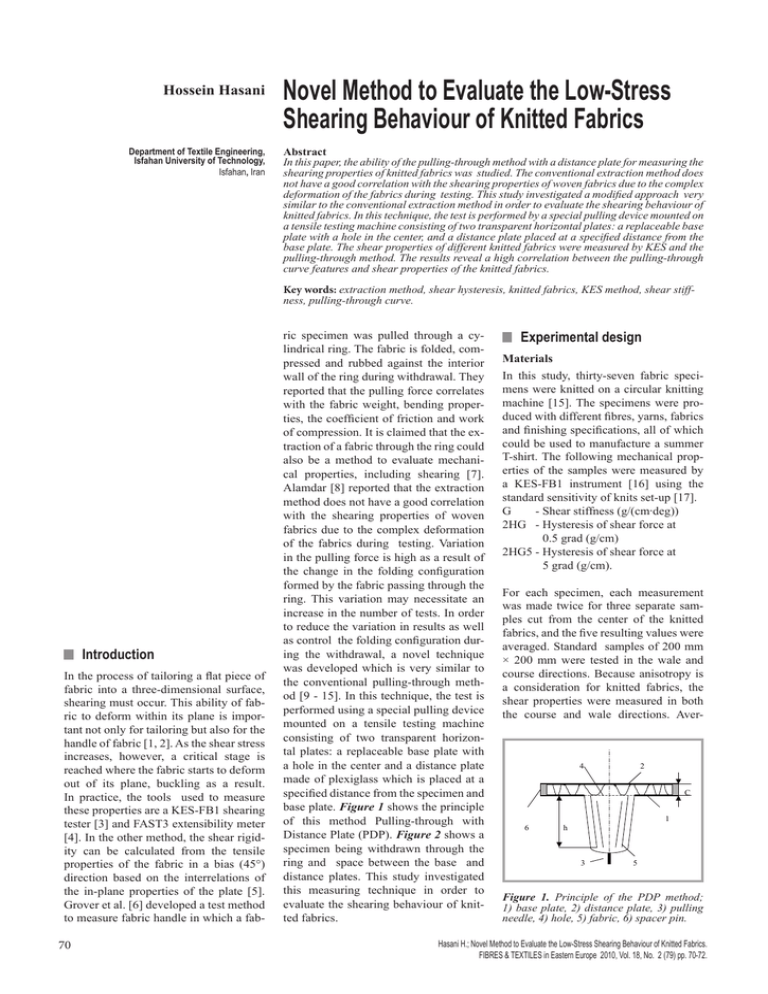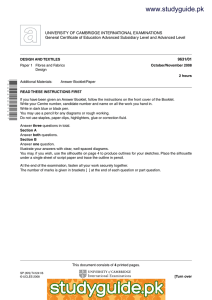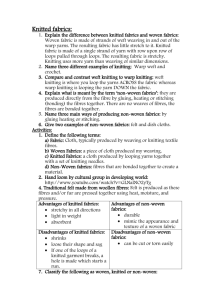Novel Method to Evaluate the Low-Stress Shearing Behaviour of Knitted Fabrics
advertisement

Hossein Hasani Department of Textile Engineering, Isfahan University of Technology, Isfahan, Iran Novel Method to Evaluate the Low-Stress Shearing Behaviour of Knitted Fabrics Abstract In this paper, the ability of the pulling-through method with a distance plate for measuring the shearing properties of knitted fabrics was studied. The conventional extraction method does not have a good correlation with the shearing properties of woven fabrics due to the complex deformation of the fabrics during testing. This study investigated a modified approach very similar to the conventional extraction method in order to evaluate the shearing behaviour of knitted fabrics. In this technique, the test is performed by a special pulling device mounted on a tensile testing machine consisting of two transparent horizontal plates: a replaceable base plate with a hole in the center, and a distance plate placed at a specified distance from the base plate. The shear properties of different knitted fabrics were measured by KES and the pulling-through method. The results reveal a high correlation between the pulling-through curve features and shear properties of the knitted fabrics. Key words: extraction method, shear hysteresis, knitted fabrics, KES method, shear stiffness, pulling-through curve. n Introduction In the process of tailoring a flat piece of fabric into a three-dimensional surface, shearing must occur. This ability of fabric to deform within its plane is important not only for tailoring but also for the handle of fabric [1, 2]. As the shear stress increases, however, a critical stage is reached where the fabric starts to deform out of its plane, buckling as a result. In practice, the tools used to measure these properties are a KES-FB1 shearing tester [3] and FAST3 extensibility meter [4]. In the other method, the shear rigidity can be calculated from the tensile properties of the fabric in a bias (45°) direction based on the interrelations of the in-plane properties of the plate [5]. Grover et al. [6] developed a test method to measure fabric handle in which a fab- 70 ric specimen was pulled through a cylindrical ring. The fabric is folded, compressed and rubbed against the interior wall of the ring during withdrawal. They reported that the pulling force correlates with the fabric weight, bending properties, the coefficient of friction and work of compression. It is claimed that the extraction of a fabric through the ring could also be a method to evaluate mechanical properties, including shearing [7]. Alamdar [8] reported that the extraction method does not have a good correlation with the shearing properties of woven fabrics due to the complex deformation of the fabrics during testing. Variation in the pulling force is high as a result of the change in the folding configuration formed by the fabric passing through the ring. This variation may necessitate an increase in the number of tests. In order to reduce the variation in results as well as control the folding configuration during the withdrawal, a novel technique was developed which is very similar to the conventional pulling-through method [9 - 15]. In this technique, the test is performed using a special pulling device mounted on a tensile testing machine consisting of two transparent horizontal plates: a replaceable base plate with a hole in the center and a distance plate made of plexiglass which is placed at a specified distance from the specimen and base plate. Figure 1 shows the principle of this method Pulling-through with Distance Plate (PDP). Figure 2 shows a specimen being withdrawn through the ring and space between the base and distance plates. This study investigated this measuring technique in order to evaluate the shearing behaviour of knitted fabrics. n Experimental design Materials In this study, thirty-seven fabric specimens were knitted on a circular knitting machine [15]. The specimens were produced with different fibres, yarns, fabrics and finishing specifications, all of which could be used to manufacture a summer T-shirt. The following mechanical properties of the samples were measured by a KES-FB1 instrument [16] using the standard sensitivity of knits set-up [17]. G - Shear stiffness (g/(cm.deg)) 2HG - Hysteresis of shear force at 0.5 grad (g/cm) 2HG5- Hysteresis of shear force at 5 grad (g/cm). For each specimen, each measurement was made twice for three separate samples cut from the center of the knitted fabrics, and the five resulting values were averaged. Standard samples of 200 mm × 200 mm were tested in the wale and course directions. Because anisotropy is a consideration for knitted fabrics, the shear properties were measured in both the course and wale directions. Aver- 4 2 C 6 1 h 3 5 Figure 1. Principle of the PDP method; 1) base plate, 2) distance plate, 3) pulling needle, 4) hole, 5) fabric, 6) spacer pin. Hasani H.; Novel Method to Evaluate the Low-Stress Shearing Behaviour of Knitted Fabrics. FIBRES & TEXTILES in Eastern Europe 2010, Vol. 18, No. 2 (79) pp. 70-72. ages of the wale and course measurements were calculated for further analysis. Specimen testing was conducted in standard atmospheric conditions of 20 °C ± 2 °C temperature and 65% ± 2% relative humidity. Furthermore, the fabrics were tested by the PDP method and the pulling-through curves analysed. The specimen of these fabrics and their specifications have been presented in our previous research work [15]. Sample preparation and test method A circular fabric sample (100 cm2), held by the pulling needle, is placed on the base plate and pulled downwards through the hole and space between the two plates (Figure 1). The angle of the fabric’s movement through the hole changes 90° [15]. The fabric specimen buckles, and shear forces arise in the fabric. When a distance plate is used, fabric shearing occurs more intensively since the use of a distance plate multiplies the number of creases. The force required is measured with respect to the displacement of the specimen and recorded as a force-displacement curve. The pulling force is required to overcome the bending and shearing forces. A typical pulling-through curve (force-displacement curve) obtained by the PDP method is shown in Figure 2. A new approach to clarify the correlation between shear properties and pulling-through curves Although it is assumed and has been theoretically proven that information related to the mechanical properties of the fabric is contained in the pulling-through curve, there is no direct method available to derive this information and transform it into well-defined physical and mechanical parameters or to identify specific characteristics on the curve corresponding to known fabric properties. Due to the lack of directly available means, statistical correlation analysis was used. In the first approach, each of the knitted fabrics was tested using the PDP method, Figure 2. Force - displacement curve obtained from the PDP method. and the pulling-through curve obtained was fed into a computer via a data acquisition system in the form of a discrete data set, denoted as X. X = (X1, X2, X3, ..., Xn), n = 24 (1) A data set was obtained from the distance between the starting point and peak point of each pulling-through curve. The result of the numeric differentiation of data set X, denoted as Z, is as follows: Zk = X n − X n −1 , k = 1, 2, …,12. (2) Q Q is the interval between Xn and Xn-1, which is assumed to be constant for all pulling-through curves. In fact, Zk represents the slopes of various locations on the pulling-through curve. Thus, for each fabric sample there are now two data sets: one from five primary hand values and the Zk set from the numerical differentiation of the X set. Statistical correlation analysis is used to correlate these data sets. Selection of pulling through curve features In the second step, an easer and simpler approach to examine the shape of the curve was used. Six characteristics of the pulling-through curve be easily extracted from the pulling-through curves. n Results and discussions In order to understand how shear properties are associated with features extracted from the pulling-through curves of knitted fabrics, a Pearson’s correlation analysis was made using shear properties of the fabrics as the dependent variables. Table 1 shows the correlation coefficients of the analysis. The correlation analysis of features extracted from the pulling-through curves and shearing properties, as measured by KES-FB instruments, supports these results. Table 2 (see page 72) shows coefficients of the correlation between features extracted from the pulling-through curves and the original physical and surface properties. Shear properties are important parameters which influence the features of pulling-through curves significantly. The findings reveal that the influence of shear stiffness (G) on the initial slope (Sf) is more than other pulling-through curve Table 1. Correlation coefficients between shear properties and pulling-through features; * Significant at the 0.05 level, ** Significant at the 0.01 level. Properties Z1 Z2 Z3 Z4 Z5 Z6 Z7 Z8 Z9 Z10 Z11 Z12 2HG 0.768 0.663** 0.477** 0.64** 0.74** 0.651** 0.376* 0.46** 0.548** 0.427** 0.289 0.434** 2HG5 0.781** 0.651** 0.451** 0.621** 0.732** 0.65** 0.401** 0.455** 0.562** 0.432** 0.282 0.416** G 0.784** 0.586** 0.382** 0.611** 0.71** 0.482** 0.241 0.479** 0.547** 0.425** 0.211 0.391* FIBRES & TEXTILES in Eastern Europe 2010, Vol. 18, No. 2 (79) 71 Table 2. Correlation analysis between features extracted from pulling-through curves and shear properties; * significant at the 0.05 level, ** significant at the 0.01 level, Fm - maximum force, Hm - peak location, A - area under pulling-through curve, Sf - initial slope of the pulling-through curve, Ss - second slope of the pulling-through curve, Sp - slope on the pulling-through curve at peak point. Properties 2HG Fm 0.727** Hm 0.324* A 0.713** Sf 0.782** Ss Sp 0.544** 0.532** 2HG5 0.715** 0.284 0.699** 0.792** 0.521** 0.530** G 0.660** 0.224 0.644** 0.820** 0.457** 0.504** Figure 3. Relationship between the initial slope (Sf) of the pulling-through curve and shear stiffness (G). features. Since the initial slope has the highest correlation with the shear stiffness. Figure 3 shows the relationship between the shear stiffness (G) and the initial slope (Sf). The significant correlation between the KES quantitative parameters and measured features extracted from the curves of the modified pulling-through method indicates the better ability of this method to measure shearing properties as compared with the conventional pulling-through method. n Conclusion The shearing behaviour of knitted fabrics was evaluated using a new extraction method, which is very similar to the conventional extraction method. In this technique, the specimen is pulled through a hole and two transparent horizontal plates. When a fabric specimen is pulled through the hole, creases will be generated, and consequently shear forces appear in the fabric. When a distance plate is used, fabric shearing occurs more intensively since the distance plate multiplies the number of creases. Six characteristics of pulling-through curves obtained from different knitted fabrics were chosen and extracted. The correlation coefficients be- 72 tween features extracted from the pullingthrough curves and shearing properties, measured by KES-FB instruments, were investigated. The results show that there is a significant correlation between shear properties and features extracted from pulling-through curves. The initial slope of the curves had the highest correlation with the shear properties. Curve features of the modified extraction method (PDP method) can be used to evaluate the shearing behaviour of fabrics. Thus, shear properties are important parameters which influence pulling-through curve features. The correlation between KES quantitative parameters and measured features extracted from the curves of modified pulling-through method indicates the better ability of this method to measure shearing properties in comparison to the conventional pulling-through method. References 1.Kilby W. F.; Shear Properties in Relation to Fabric Hand. Textile Res. J. 31, (1961) pp. 72-73. 2.Morooka H., Niwa M.; Physical Properties of Fabrics Relating to Making Up and Good Appearance. J. Text. Mach. Soc. Jpn. 24, 1978 pp. 105-114. 3.Kawabata S., Niwa M.; Fabric performance in clothing and clothing Manufacture, J. Text. Inst., 80, 1989, No 1. 4.Kadole P. V.; Fabric Assurance by Simple Testing, Textile Processing, September 1995. 5.Kilby W. F.; Planar Stress-Strain Relationship in Woven and Fabrics. J. Text. Inst., 54, 1963, pp. T9-27 6. Grover G., Sultan M. A., Spivak S. M.; Screening Technique for Fabric Handle J. Text. Inst., vol. 23, No. 3, 1993, pp. 486-494. 7.Pan N., Yen K. C.; Physical Interpretations of Curves Obtained Through the Fabric Extraction Process for Handle Measurement, T.R.J. 62, 59, 1992 pp. 279-290. 8.Alamdar-Yazdi A.; A New Method to Evaluate Low-stress Shearing Behaviour of Woven Fabrics, Indian Journal of Fibre & Textile Research, Vol. 29, September 2004, pp. 333-338. 9.Seidel A.; Griffbewertung von Strumpfwaren mit dem ITV-Griff-Tester, Melliand Textilberichte, 6/2001, pp. 491-494 10.H asani H.; Determination of Handle of Knitted Fabrics Using an Objective Measuring Technique, Indian Journal of Fiber & Textile Research, Vol. 34, 2009, pp. 245-252. 11.Truncyte D., Papreckiene L., Gutauskas M. ‘Behaviour of Textile Membranes while Being Pulling Through a Hole by the Constrained Method’, Fibres & Textiles in Eastern Europe, Vol.15, No. 1(60), 2007 pp. 50-54. 12.Naujokaityte L., Strazdiene E., Domskiene J. ‘Investigation of Fabric Behaviour In Bias Extension AT Low Loads’, Fibres & Textiles in Eastern Europe, Vol. 16, No. 5 (70), 2008 pp.59-63. 13.Daukantiene V., Papreckiene L., Gutauskas M.; ‘Simulation and Application of the Behaviour of a Textile Fabric while Pulling It through a Round Hole’, Fibres & Textiles in Eastern Europe, Vol. 11, No. 2 (41), 2003, pp. 37-41. 14.S trazdiene E., Gutauskas M.; ‘New Method for the Objective Evaluation of Textile Hand’, Fibres & Textiles in Eastern Europe, Vol. 13, No. 2 (50), 2005, pp. 35-38. 15.Hasani H., Planck H.; Analysis of the Physical Fundamentals of an Objective Integral Measuring System for the Determination of the Handle of Knitted Fabrics., FIBRES & TEXTILES in Eastern Europe 2009, Vol. 17, No. 6 (77) pp. 70-75. 16.Kawabata S.; “The Standardization and Analysis of Hand Evaluation”, The Textile Machinery Society of Japan, Osaka, 1980. 17.Kawabata Evaluation System for Fabrics Manual, Kato Tech. Co. Ltd, Kyoto, Japan. Received 17.07.2009 Reviewed 22.01.2010 FIBRES & TEXTILES in Eastern Europe 2010, Vol. 18, No. 2 (79)






